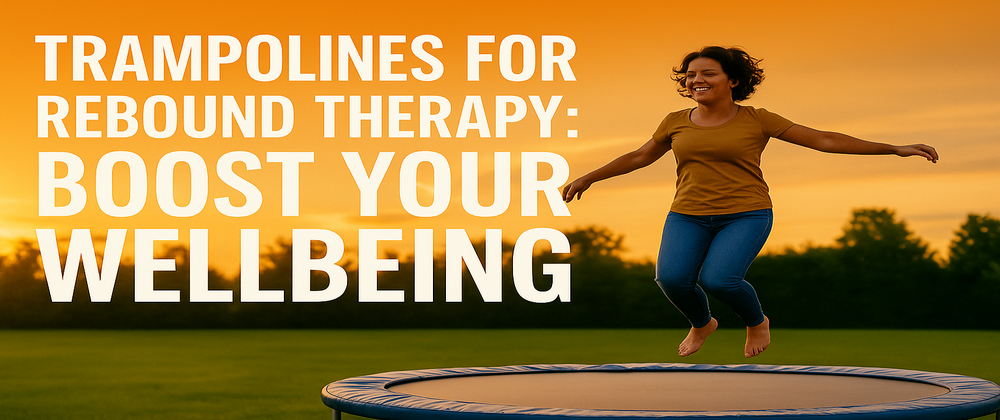
Trampolines For Rebound Therapy
Ever seen someone grinning ear-to-ear on a trampoline? That bounce isn’t just fun—it’s therapy. Trampolines in rebound therapy boost balance, strength, and confidence. Want to know how a simple jump can improve health and happiness? Keep reading—you’ll be jumping for joy too!
Therapeutic Benefits
Physical Benefits
Think of rebounding as your body’s personal tune-up. It gets your heart pumping, improves blood and lymphatic circulation, and helps strengthen muscles without harsh impact. Regular sessions build core strength and flexibility, making everyday movements feel easier. Best of all? It’s low-impact, so it’s kind to your joints while still giving you a full-body workout.
Cognitive Benefits
You’re not just bouncing—you’re thinking, reacting, and coordinating. Rebound therapy enhances spatial awareness, motor planning, and focus. It’s especially helpful for children with developmental challenges and older adults who want to keep their minds sharp. Simple movements can lead to meaningful brain boosts.
Emotional and Social Benefits
Bouncing is fun—plain and simple. But beyond the smiles, there’s science. Rebound therapy helps lower stress levels, improve mood, and reduce symptoms of anxiety and depression. Group sessions or family bouncing time also bring people together, helping to build social connections and confidence.

Choosing the Right Trampoline for Rebound Therapy
Types of Trampolines
Mini-trampolines (Rebounders)
These compact powerhouses are perfect for homes, flats, and smaller therapy rooms. They’re easy to store, quick to set up, and great for short, focused sessions. A popular choice for individuals or families who want flexibility without needing loads of space.
Larger Therapeutic Trampolines
If you have the room, these offer more bounce for your buck. With a bigger surface area, they’re ideal for structured therapy sessions in clinics or schools. Many come with additional safety features and support bars, making them suitable for users with limited mobility.
Key Considerations
Safety Features
Safety should never be an afterthought. Look for soft-edge padding, anti-slip mats, and secure handles. Some models include enclosures or support rails to keep users steady and confident.
Size and Weight Capacity
Think about who’ll be using the trampoline—and where. Mini rebounders are ideal for personal use, while larger trampolines cater to groups or users needing extra space. Always check the weight limit to ensure safe and comfortable bouncing.
Frame and Matting Quality
Quality matters. Strong frames ensure stability, while high-tension mats provide a smooth, even bounce. If it feels too loose or too tight, it’s probably not right. Look for sturdy construction and user reviews before buying.

Rebound Therapy Techniques and Exercises
Basic Jumping Techniques
Start simple. A gentle bounce with both feet firmly on the mat is a great way to begin. These basic movements increase blood flow and warm up the body. Think of it like shaking off the cobwebs before diving into more focused exercises.
Incorporating Therapeutic Movements
Stretching and Flexibility Exercises
Try bouncing while reaching your arms overhead or twisting gently at the waist. These moves stretch out muscles and keep joints limber. It’s a great way to combine flexibility and fun in one go.
Strengthening Exercises
Want stronger legs or a more stable core? Add small squats or knee lifts while bouncing. Over time, these moves help improve posture, stamina, and overall strength.
Balance and Coordination Exercises
One-footed bouncing might sound tricky, but it’s a powerful tool for improving balance. Combine it with side steps or arm movements to challenge coordination. These playful movements can offer big benefits, especially for those with balance issues.

Rebound Therapy in the UK
Finding Qualified Therapists and Facilities
Across the UK, many clinics and therapy centres now offer rebound therapy. Look for certified providers with trained staff who understand how to tailor sessions to different needs. Whether you're recovering from injury or supporting a loved one with disabilities, there's likely a local expert ready to help.
Resources and Support Organizations
Several UK-based organisations are dedicated to making rebound therapy accessible. Rebound Therapy.org offers training and guidance, while companies like ACON Trampolines and BERG supply trusted equipment. Whether you’re a parent, teacher, or therapist, there’s a growing network of support to tap into.
Safety and Precautions
Supervision and Guidance
Never bounce alone—especially in a therapeutic setting. Always have supervision when starting out, particularly for those with health conditions or limited mobility. Trained guidance ensures the experience is safe, structured, and effective.
Addressing Potential Risks
Like any exercise, there are risks if not done properly. Regularly inspect your trampoline for wear and tear. Stick to recommended techniques, and always get a health professional’s go-ahead if you’re unsure. With the right approach, rebound therapy is not only safe—it’s life-enhancing.


Leave a comment